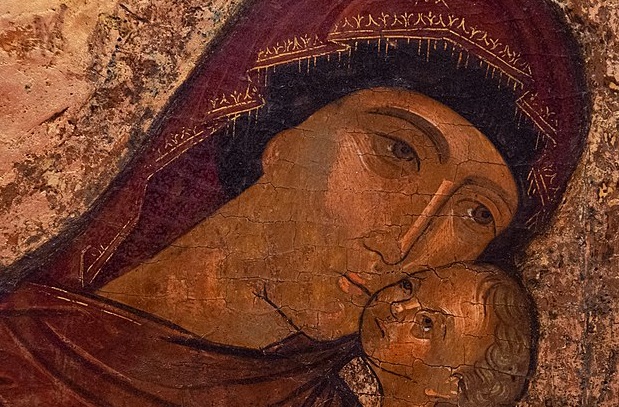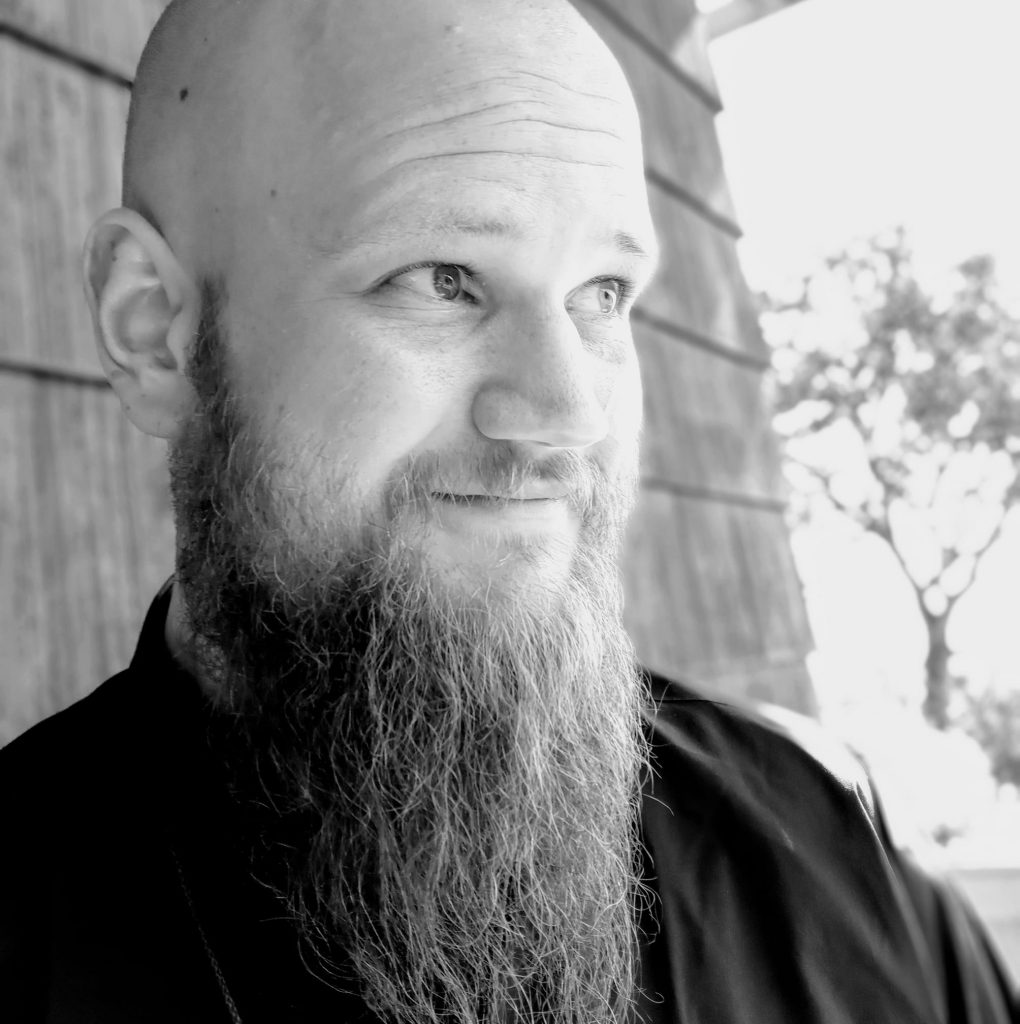Rev. Thom Muller

In our Judeo-Christian tradition, it seems, we have often limited our concept of the Divine to masculine images. More and more, people are expressing how constrained they are in their traditional view of God. Looking at my own life, and how I feel the Divine has manifested in it, I personally feel that there is a lot of spiritual and psychological significance to the experience of motherly love. I’m not trying to be essentialist here, I have seen what I would call motherly love in many people who are not biological mothers, as well as folks who are not biologically female.
There’s something about a motherly presence. I associate this motherly presence with some of my earliest childhood memories of my mother tucking me into bed and kissing me goodnight. There’s something archetypal and almost primal about that experience of unconditional love and security, that I believe is a manifestation of the Lord’s love for us.
Veneration of Mary goes back to the 2nd and 3rd century A.D.. Collyridianism, an early Christian sect in Arabia, worshipped Mary as mother deity. Today, it is mostly the liturgical movements (Catholicism, the Anglican Communion, Eastern Orthodox Churches). Growing up Roman Catholic in Germany, I always felt a very deep connection with Mary, as a figure which represents a “motherly” spiritual quality, a way to relate to the divine not in the usual, predominantly patriarchal images that are common in Western religion.
Clearly, the Christian engagement with the character of Mary has served as an outlet in Western Religion to imagine the Divine outside of a male-centric framework. I can only speculate, as a man, how powerful this has been for Women in a patriarchal society and religious environment. So there seems to be something very powerful, spiritually valuable in the image of Mary.
In 1950, when Pope Pius XII proclaimed the dogma of the assumption of Mary (the belief that she rose physically to heaven), Carl Jung’s response was that this was the most significant movement in Christianity since the Reformation. He, of course, considered the psychological and socio-cultural significance of the narrative (we all know he wasn’t even Catholic). He considered Mary to represent the “Mother Archetype”, and saw the elevation of Mary as a profound step towards integrating a deep psycho-spiritual need in our engagement with the Divine.
Throughout history, different Mystics have engaged the theme of Mary really beautifully. One that stands out is the 13th Century German Christian mystic Meister Eckhart, who suggested that the virgin birth, the carrying and birthing of the divine, was a universal spiritual experience we all ought to go through. Joseph Campbell picks up on this. “the birth of spiritual person out of animal person,” (or the spiritual person emerging out of the natural person) and what he calls “the birth of compassion.” He also mentions the universality of the narrative of the “virgin birth” throughout cultures and world religions. In The Power of Myth, he states:
“Heroes and demigods are born this way, as beings motivated by compassion and not mastery, or self-preservation. This is the sense of the second birth, when you begin to live out of the heart center rather than from selfish motivation.” (1)
So, there are all these beautiful ways to engage with the image of Mary. And of course, Swedenborg has something to say. I’m assuming most of us that would identify as “Swedenborgian” are comfortable with a variety and diversity in approaching the Divine. Swedenborg emphasizes the transcendence of the Divine, which is not bound by time or space, and which lies at the very center and core of all life, the underlying reality of everything. He also emphasizes the importance of relating to the divine through a divine-human manifestation, that we, in our humanity, can relate to. And he has a very high, incarnational Christology.
Yet we all know that the dominant voice in this discussion, in our patriarchal society, has been male, and there is an undoubtable male bias in our many traditions. In the first reading, from the Psalms we encountered one of many instances in the Word where the Divine is illustrated in a distinctly feminine way. Suffice it to say that I don’t think this discussion needs to be about the idea of a divine gender, rather, I think we’re a level beyond, a deeper level of spiritual meaning. Those of you who are seasoned in a Swedenborgian tradition know that traditionally, sectarian Swedenborgians haven’t exactly been known to venerate the Virgin Mary. One reason for this is that Swedenborg, like folks such as Campbell and Meister Eckhart, places great emphasis on Mary’s humanity. Hand in hand with common religious conceptionalizations of Mary in some traditional Christian movements goes the belief in her as being “immaculate”, (or “spot-less” in English). So the term “immaculate conception” doesn’t actually refer to Mary’s sexual virginity, but her “sin-less”, quasi-divine nature. This of course often ties in to a belief which we know Swedenborg was not a big fan of, “Original Sin”.
Swedenborg, in his interpretation of the Christ narrative, and the metaphysics behind it, focusses on Mary’s human side. He understands Christ’s mission as the story of a struggle between Humanity and Divinity, eventually reconciling them in what he calls his “Glorification”. So one side of Christ is his divine identity, his divine, soul, core or essence, and the other side is the human condition, with everything that goes with being born as a human being. The genetically inherited flaws, unhealthy inclinations, “temptations”. To me, this represents a cataclysmic and salvific union of Humanity and Divinity. And in the Christ-Narrative, we encounter the Divine Humanity which is at the core of Swedenborg’s concept of what he refers to as “the Lord”. So it is Mary’s gift of humanity, and the human-ness of her motherhood, which enables this process.
This, of course, does not paint a negative image Mary. In fact Swedenborg relates in several of his works, a vision of Mary that he had in the spiritual world. He sees her sort of pass by, dressed in beautiful robes and she speaks to him very humbly about her role and mission. (Spiritual Diary §5834, True Christianity §827)
I think there is something about Mary in this framework that is easily overlooked. Swedenborg believed that the Lord’s humanity was present with him from birth, but that he gradually, through time, became aware of his own divinity. This makes me wonder what role Christ’s experience of Divine Love AND Wisdom that he had with his mother, mary, played in this process. I wonder if he had fond memories of her tucking him into bed and kissing him goodnight.
So, now that we have looked at all these different wonderful interpretations of the character of Mary, we might, again, be walking away with more questions than answers. Some of those questions, to me, include: How do we engage the character of Mary in both its symbolic, and correspondential fullness, in a way that brings forth a deeper connection between the Divine, and our true, angelic Selves? How does the character of Mary in the Word represent different aspects of our own journey, as well as aspects of the Divine? What does it mean for us, to “give birth to divinity out of humanity?
What role, generally, does gender play in our personal engagement with the Divine? Is this something we struggle with?
Today, I invite all of us to meditate on the times that we have felt the Lord’s love manifest in us. One of the take-aways for me is to approach both the character of Mary, and the concepts of divine femininity and masculinity with an open, thankful, and holistic mind-set. Being aware that there are countless, infinite ways in which the Divine shows him/her/itself to me. To appreciate them indiscriminately. And being willing, and courageous, just like Mary, to birth God into this world, to be willing to receive and to share the Divine Love and Wisdom which mothered us into existence.
(1) Campbell, Joseph, and Bill D. Moyers. The Power of Myth. New York: Doubleday, 1988.

Rev. Thom Muller is pastor at the Swedenborgian Society of the East Bay at Hillside, an Urban Sanctuary, in El Cerrito, CA, as well as senior editor of Our Daily Bread. His passions include the intersection of spirituality and psychology, interfaith theology, and the Western esoteric tradition. A native of Germany, Rev. Muller was ordained into the ministry of the Swedenborgian Church of North America in 2016, upon receiving his theological education at Bryn Athyn College of the New Church and the Center for Swedenborgian Studies and Pacific School of Religion at the Graduate Theological Union in Berkeley.